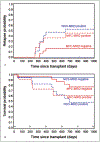Advances in hematopoietic cell transplant for the treatment of hematologic malignancies
- PMID: 30585866
- PMCID: PMC7461816
- DOI: 10.1097/MOP.0000000000000729
Advances in hematopoietic cell transplant for the treatment of hematologic malignancies
Abstract
Purpose of review: Incorporation of minimal residual disease (MRD) testing in acute lymphoblastic leukemia (ALL) and acute myeloblastic leukemia (AML) has transformed the landscape of hematopoietic cell transplantation (HCT). Pre-HCT MRD has allowed prognostication of HCT outcomes for high-risk leukemia patients, whereas the detection of post-HCT MRD has allowed for interventions to decrease relapse.
Recent findings: In this review, we emphasize studies from the past two decades that highlight the critical role of MRD in HCT in pediatric ALL and AML. Advances in MRD detection methodology, using next-generation sequencing, have improved the sensitivity of MRD testing allowing for more accurate predictions of HCT outcomes for patients with relapsed and refractory ALL and AML. In addition, novel pre-HCT therapies, especially immunotherapy in ALL, have dramatically increased the number of patients who achieve MRD-negative remissions pre-HCT, resulting in improved HCT outcomes. Post-HCT MRD remains a challenge and new therapeutic interventions are needed to reduce post-HCT relapse.
Summary: As immunotherapy increases pre-HCT MRD-negative remissions, and next-generation sequencing-MRD is incorporated to improve the sensitivity of MRD detection, future clinical studies will investigate less toxic HCT approaches to reduce long-term sequelae and to identify which patients may benefit most from early post-HCT intervention to reduce relapse.
Conflict of interest statement
Conflicts of interest
There are no conflicts of interest.
Figures


References
-
- Hunger SP, Mullighan CG. Acute lymphoblastic leukemia in children. N Engl J Med 2015; 373:1541–1552. - PubMed
-
- Rasche M, Zimmermann M, Borschel L, et al. Successes and challenges in the treatment of pediatric acute myeloid leukemia: a retrospective analysis of the AML-BFM trials from 1987 to 2012. Leukemia 2018; 32:2167–2177. - PMC - PubMed
-
Five-yearprobabilityofoverallsurvivalincreasedfrom49 ± 3%(1987–1992)to76 ± 4% (2010–2012) for pediatric AML, but pEFS only improved from 41 ± 3% (1987–1992) to 50 ± 2% (1993–1998) and nonresponse and relapse rates remained constant.
Publication types
MeSH terms
Grants and funding
LinkOut - more resources
Full Text Sources
Other Literature Sources
Research Materials
Miscellaneous

